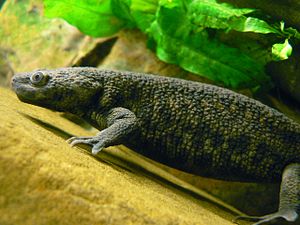Spanish ribbed newt
| Spanish ribbed newt | ||||||||||||
|---|---|---|---|---|---|---|---|---|---|---|---|---|

Spanish ribbed newt ( Pleurodeles waltl ) |
||||||||||||
| Systematics | ||||||||||||
|
||||||||||||
| Scientific name | ||||||||||||
| Pleurodeles waltl | ||||||||||||
| Michahelles , 1830 |
The Spanish pleurodeles ( Pleurodeles waltl ) is an amphibian - kind from the family of Real Salamander . Together with the olm , it is the largest salamander in Europe.
features
The species becomes 28 to 31 centimeters long and is built accordingly strong. The ear-glandless head is broad and strongly flattened; the eyes are small and upward. 8 to 10 conspicuous, orange to brownish bumps (rib glands) on the sides of the body can reveal the pointed ends of the ribs and even occasionally pierce the skin without damaging the animal. This is a defense against predators, as skin poison gets into the wounds of their oral cavity with the tips of the ribs. The laterally flattened tail is about as long as the head and trunk. The skin surface looks wrinkled and warty due to the many small horn bumps. The yellow-brown, olive-green or gray basic color is dissolved by dark, washed-out spots. The ventral side is lighter and darkly marbled.
During the mating season, low fin fringes appear on the tail, which become slightly higher in the males. They also have rough, black oestrus calluses on the insides of the front legs and inner fingers, and their front extremities are longer than those of the more stocky females.
Occurrence, way of life
The Spanish ribbed newt can be found in Portugal , in central and southern Spain and in parts of Morocco . It occurs in sparse pine forests , in gardens and in steppe-like wasteland and prefers rather low-lying regions. In central Spain, however, the species has also been found up to 1500 meters above sea level. As spawning waters, different types of water that are as herbaceous as possible are sought out - due to the relatively poor landscapes that are populated, the Spanish black newt cannot be very demanding.
During terrestrial phases of life - for example when their living waters dry out in summer - the animals hide under stones and dead wood. It is not uncommon for them to be aquatic all year round . There is no hibernation. The food spectrum includes insect larvae, worms, crustaceans and smaller water newts - species-specific cannibalism also occurs. The ribbed newts themselves are mostly eaten by the viper snake ( Natrix maura ).
Reproduction, individual development
The mating season is from November to January. The male clasps the female's forelegs and presses his head against the female's throat. The couple swims around in this position for many hours, sometimes two full days. Eventually, several spermatophores are transferred . A little later, 150 to 800 eggs are attached to aquatic plants in smaller, gelatinous lump portions by the female . After about one and a half to two weeks of embryonic development , the larvae, initially 11 to 12 millimeters in size, hatch.
Between mid-April and July, depending on the region, the converted 7 to 9.5 centimeters long young go ashore. They are sexually mature after 16 months - even if they have not left the water.
Taxonomy
The genus and species were described in 1830 by Karl Michahelles in his article New southern European amphibians in the journal Isis . The Spanish ribbed newt is the type of the genus. The species was discovered by Michahelles after Dr. Waltl, who brought some specimens from southern Spain, where they were often found in Brunnen, to Munich.
attitude
Spanish ribbed newts are also easy to breed pets and are therefore sometimes kept in aquariums all year round (if possible with a small area of land). Because of their size, however, they need a spacious pool and a corresponding need for food. They can live to be around 10 to 15 years old or more.
Individual evidence
- ↑ Karl Michahelles: New southern European amphibians. Isis von Oken, XXIII, pp. 189-195 and the like. Pp. 806–809, Leipzig 1830, pp. 191–195 (first description) ( facsimile at Biodiversity Heritage Library)
literature
- Nöllert, A. & C. Nöllert (1992): The amphibians of Europe. Kosmos nature guide. ISBN 3-440-06340-2
- Karl Michahelles : New Southern European Amphibians. Isis von Oken, XXIII, pp. 189-195 and the like. Pp. 806–809, Leipzig 1830, pp. 191–195 (first description) ( facsimile at Biodiversity Heritage Library)
Web links
- Pleurodeles waltl at Fauna Europaea
- Photos of the Spanish ribbed newt on www.herp.it
- Pleurodeles waltl in the endangered Red List species the IUCN 2006. Posted by: Beja et al , 2006. Retrieved on 11 May, 2006.
